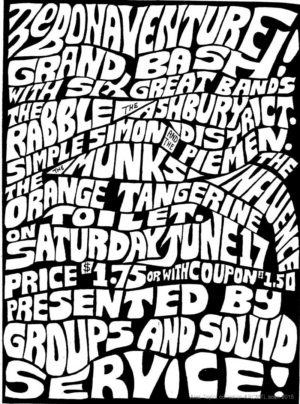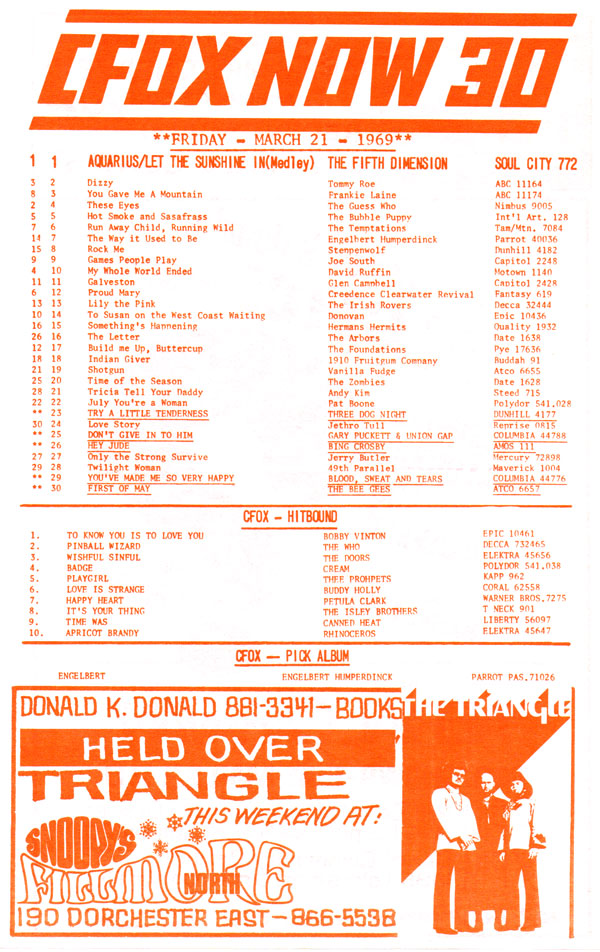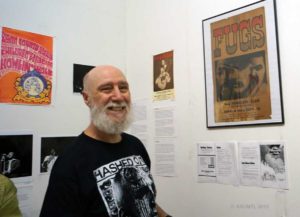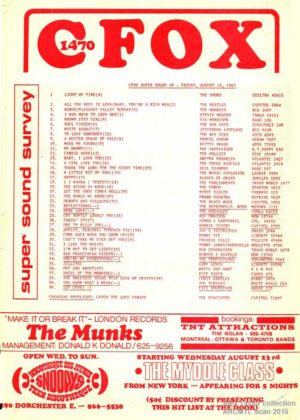Working the door at the New Penelope with Allan Youster
Allan Youster has been a mainstay in the audience at local concerts for decades in Montreal. He spent part of the late 1960s working the door at legendary local concert venue The New Penelope Café, witnessing performances by such figures as Muddy Waters, The Fugs, Jesse Winchester and Frank Zappa and the Mothers of Invention. Louis Rastelli spoke to him for this project at one of his favourite local haunts, Barfly, in the summer of 2015, and followed up a few months later at his longtime home in the Milton-Parc co-op in the fall of 2015. (He was also interviewed HERE for an oral history of the Milton-Parc housing battles of the 1970s). The interviews were transcribed and edited by Alex Taylor and Louis Rastelli, with graphics provided by Erik Slutsky, Alex Taylor and others.
LR: Were you born and raised in Montreal?
AY: I was born just over there on Coloniale (near Duluth). Then my parents moved up to St-Joseph Boulevard, then we moved again with the big Jewish migration west. We only made it as far as the cheap apartments in St-Laurent. Some of our family ended up in Chomedey and other places. My mother was from Glasgow, but my father was a Montreal Jew. He lied about his age at 17 and went off to fight in World War II. Even though the war ended in 45, it took over a year to get back home. My mother was a war bride, she had come over then too. So I was born in 1947. I went to Sir Winston Churchill High School in the early 1960s.
LR: Ville Saint-Laurent was brand new then, wasn’t it?
AY: I went to Sir Winston in its first year! It was on the edge of Cote-Vertu; behind the school was all fields. West of Alexis Nihon, Cote-Vertu was a two-lane country road like Gouin Boulevard, there were only farms and stables out there. I remember one day, the school shook — Canadair (the airplane manufacturer on Thimens, now Bombardier) was a little ways over east, then Dorval Airport was just west of us. They had a runway number 7 at Dorval, and a runway number 7 at Canadair. So a passenger plane coming in had mistaken which runway, and came in so low that the vibrations shook the whole school. It made the papers – they ended up closing that runway at Canadair after that.
LR: They don’t test their planes there anymore …
AY: No, no. It’s amazing what’s there now; they’ve just built and built. Actually the first show I ever saw was back in Ville St-Laurent, at the Y, I saw Penny Lang there. She had a bass player with her and sang cover tunes. I think the building is still there.
LR: By coincidence, I went to kindergarten at that Y, up near Poirier.
AY: Yeah, up there. We had a teacher in high school who started a folk music club. That was where I first heard Bob Dylan, she played the first album for us. Phil Ochs, all this before the Beatles, maybe 61, 62.
When we were in the Folk Song Club, we were the only ones who cared about that music, and we were just a bunch of nerds. It wasn’t popular at all. You have to understand, Dylan’s only single was Tambourine Man. It was slow and 6 minutes long, so it got played at all the high school dances. This was way before Stairway to Heaven. But he wasn’t all that popular.
The Beatles for me, were a real watershed. I discovered The Beatles in November of ‘63, before they were famous in February of ’64 from Ed Sullivan. We’re Jewish and Chanukah was coming up at the end of November and my mother says, “You have to buy your sister a gift.” I have no money, so she gives me five dollars. We’re at a record store, I see the Meet The Beatles LP, wrap it up and give it to my sister Rena. She doesn’t like it! She gives it back. I can’t believe it! I Love it!
Now we’re living in a duplex, so we do our stuff with the family and then it’s over. Afterwards, I run downstairs to my neighbours and say: “You gotta hear this!”
We put it on down there in the basement, and they called their friends, so before you know it we had about eight people listening to The Beatles going “This is incredible!” I even took it to school that December, and our history teacher who was from Scotland— Miss Chesney— she said: “Oh! I see you’ve discovered the British stuff… I was there this summer and I have all these 45s I bought.” So we had a sock-hop in our gym where I brought my record and she brought in hers… everybody took their shoes off and were dancing in the gym. We’re part of the British Empire… British stuff gets released here and just shows up in the stores whereas in the States, it took longer to come out. So by the time February comes, we were stoked for the Ed Sullivan show!!
LR: But why did it sound different? Had you really not ever heard Chuck Berry or any Motown by then? Songs like the original “Twist & Shout”?
AY: You have to understand that you can’t throw the black charts at us. We were still at the end of the black “race records” era. We had Dean Hagopian. Dean was the big CFOX adversary of Dave Boxer at CFCF. Dave Boxer was the most popular, but Dean Hagopian was the most hip, because he was playing the black groups, RnB, the older stuff and the stuff not playing on the white charts. So we knew about that stuff, but it was not popular. But the Beatles arrived at the right time, in the right spot, with the right harmonies, and it just struck a chord. The first song I ever heard was “It Won’t Be Long”… that was like church music call & reply. It captured me at the time… it captured everybody, it was amazing! At this point, you can’t find other records like that. My mother’s from Scotland, so we wrote to our relatives there to send us more Beatles stuff.
LR: It must have been like such a breath of fresh air?
AY: Yeah! It was somehow releasing. All of us, after that whole thing hit, everybody was going, ‘Hey! I can do that!” Later on, we got to hear all that other stuff. The British bluesmen re-introduced America to its own music.
So my mother’s relatives sent us more Beatles and other stuff from Scotland. The day I got the first album, a friend of mine, Larry Geary, knocked on my door at 8:15 in the morning before school, and he had a new record… Paul Butterfield’s first album with “Born in Chicago” on it. Anyways, he says: “You gotta hear this” and we put it on and my mother came in and said: “Why is it so loud?” and I said: “Mom, it says on the back of the cover—Play as Loud as you can!” (laughs). We were open to all that, listening to Butterfield, The Beatles & The Stones, Muddy…
 In high school, the pop bands that I liked were bands like JB and the Playboys. I got their albums, their 45s… I’d also see them and bands like the Haunted and MG & the Escorts at the Bonaventure Curling Club. We had a friend with a car and we would go out there. It was in an industrial park, but before the big highway was built. In the summer, they had 5 or 6 thousand kids in there. They would bring in 10 bands, one after the other. They would all get 20 minutes, half an hour and as you were a bigger name, you would get more time. The sound was terrible, the sound was cavernous! but the sound was terrible everywhere then. But it was an EVENT. It was Rock’n’Roll. People would buy a mickey of rum and sneak it in and you could buy a Coke there. It was like a high school gym, but at an industrial level.
In high school, the pop bands that I liked were bands like JB and the Playboys. I got their albums, their 45s… I’d also see them and bands like the Haunted and MG & the Escorts at the Bonaventure Curling Club. We had a friend with a car and we would go out there. It was in an industrial park, but before the big highway was built. In the summer, they had 5 or 6 thousand kids in there. They would bring in 10 bands, one after the other. They would all get 20 minutes, half an hour and as you were a bigger name, you would get more time. The sound was terrible, the sound was cavernous! but the sound was terrible everywhere then. But it was an EVENT. It was Rock’n’Roll. People would buy a mickey of rum and sneak it in and you could buy a Coke there. It was like a high school gym, but at an industrial level.
I remember a group called The Munks, they covered The Zombies’ “She’s Not There” before we heard it on the radio. But nothing stands out in memory more than THE CROWD! It was the teenage crowd, the parking lot, people looking for teenage girls, girls looking for boys, girls looking for trouble, alcohol—no drugs—if there were drugs, it was so low key we didn’t pick up on it. It was really high school on an octane level, a sock hop with alcohol. And the high school dances had bands, Winston Churchill had bands. Bands were localized, back then, a band could be local for a high school, and a few blocks away, nobody knew them. The local scene was really funny. And Donald K. Donald. I actually remember him at the Bonaventure with one of those folding wood tables, with two turntables, a Bogen amp and two speakers. He was playing the music and was getting local bands to play at high schools, and that’s how he started.
LR: He picked up bands like The Triangle…
AY: Yeah! Actually, at one point he even got some of the bands that played at The Penelope to play some of the high schools, because he was already hooked up.

A flyer that was typically free to pick up at record stores in the 1960s. From the collection of Alex Taylor.
LR: There seemed to be a brief point after The Beatles hit where a lot of the gigs at the Bonaventure or Maurice Richard Arena had a mix of French yé-yé bands & English bands like The Haunted or The Rabble…
AY: OK, well Les Classels & Les Baronets, I remember them, but I wouldn’t listen to them because, basically, that was pop crap! I mean now, it’s elevated to a place of nostalgia, but at the time — remember I said that the music was divided? – well, that was pop crap!
LR: There were others that crossed over more, maybe Les Sultans or Sinners?
AY: The Sinners, definitely! Sultans, yeah, they were moving in that direction. The one song that did it for them was “La Poupee Qui Fait Non” – that’s the stupidest song but it went to #1.
LR: I can’t help but think that these days, three years go by, and it’s not like the whole world changes. In those days, in ’64, The Beatles exploded, then by 1967 you’ve got acid-rock… it’s like the whole world changed in three years! Think of 2012’s music compared to 2015’s for example and it’s more or less the same. Did it feel as fast-paced as it seems now?
AY: Well at the time, we were listening to jazz, to folk, to rock and popular music as well. This was slightly before CKGM-FM, but there’s other stuff that’s not on the radio that we’re listening to as well. When the British stuff hit, everybody was listening to the British stuff, but not everybody was listening to Bob Dylan, to the Butterfield Blues Band or following all of “our stuff.” So there were two or three streams of popular music at the time.
For Montreal, the really big change was CKGM-FM, that was Geoff Sterling who bought that radio station. I mean, there really hasn’t been radio like that since. Even CKUT today doesn’t do that. Two years in a row, they won the best radio station in North America, picked by Rolling Stone… Geoff Sterling just let the DJs do what they want. You could turn it on, hear Hendrix followed by Ravi Shankar followed by John Coltrane… playing one long cut of each. There was nothing these people wouldn’t do! It was music, it was just “out there!” Nobody is that free-form today… Meatball Fulton was one of the deejays… free-form, but within the politics of the station…




I later got to know him at Barfly and was beyond appreciative that he approved of my work.
This article gives a great amount of depth to both him and the music-scene history of Montreal. What a great read, what a great man, and what a great city! Thanks!
..the penelope was school for all of us..sidetrack, butterfield, muddy...earth opera(google that one), tim buckley...mothers ...the list goes on and on.. goes on and on....
..and little did i know that if you reversed '67 to '76...i would be playing with the skinny kid from memphis...
He brought in some great folk performers: Dave Van Ronk, Rev. Gary Davis, John Hammond Jr. and more. I recorded some of the shows and have digitized some of them. I wonder if there is any interest in hearing those performers...
e mail me and i will return the picture.
In 1971, I shared an apartment on Souvenir St. with several members of the Sidetrack including John Lewis and his wife Sandy. Then one day, John contracted a terminal cancer and quickly headed back home to the States. Very sad.
John was a great guy, and a marvelous story teller. His first cousin was John Sebastian of the Lovin' Spoonful and those two shared a grandfather, also John Sebastian, who was a world-famous harmonica player.
I have no picture of John or indeed any pictures from the New Penelope or Sidetrack and would greatly appreciate receiving a copy of any pics you would care to share.
Cheers,
After work Gary and I and some of the people would go up to Mount Royal and smoke a joint and wait for the sun to come up. My name is Helga.
I came from TMR, as were half of the guys in Sidetrack. I was playing Keyboard in another band from the Town with Andy Higgs, who became Sidetrack's bass player. Sidetrack was the New Penelope's house band in 1967, but somehow our Band, Owed to the Blues, was able to wangle a gig as the "backup" house band on Sunday Nights. Sunday was usually pretty dead and if we were paid anything it was a pittance. The BIG payoff was that we were able get in free for many shows and hang out there as if it were our clubhouse.
I had access to my parents Chevy so I also occasionally helped Gary out by picking up musicians to bring to the club (Sonny Terry & Brownie McGee) or in one case (Darius Brubeck) up to the NFB for a filming session.
I also have great memories of the Swiss Hut which had the most amazing mix of people - a true Montreal mish-mash of franco separatists, artists, hippies, Sir George and McGill students (often patrons of Gary's place), plus working types who usually viewed the long hairs with a mixture of mistrust and contempt. My own not-so-long hair and apple-cheeked innocence gave me a fairly benign appearance which helped me to strike up some interesting conversations at the bar with "straights" from different walks of life. In particular I developed a friendship with two older guys who worked in maintenance at Morgan's department store (which had been rechristened as the Hudson's Bay a few years prior).
It was surprising how boldly one could smoke weed in the Hut. Of course, in those days the air was already blue with cigarette smoke. One evening, a group of us were in a booth waiting for our dinner and merrily passing around a fully loaded chillum. Then the cry went up that there was a police RAID in process. I was literally in mid-toke at that moment so I had to discreetly dispel a huge lungful of smoke and launch the pipe along the floor. I think the target of the raid turned out to be some specific people, not a general drug bust, so in the end we were able to finish off our meal and head back to the New Penelope.
The New Penelope and the Swiss Hut, Le Drug, Chez LouLou (aka The Bistro), The Esquire, The Blue Angel ... so many great places have come and gone.
At least we have the memories!
Get in touch, I'll let you know why Im asking. Cheers
I worked at he Boys Home of Montreal 1968/9, and frequented a number of places where music was on offer. I recall a pub on Mountain Street - The Seven Steps? - where, in return for acting as doorman I got free beer! I also went to the New Penelope Nightclub to see the Paul Butterfield Blues Band just after Mike Bloomfield had left and was replaced by Buzzy Feiten. Also bumped into Leonard Cohen and Pete Seeger. Great times!!! Weymouth, Dorset, UK